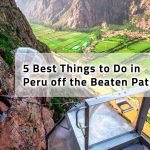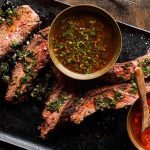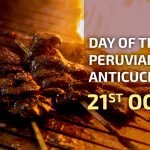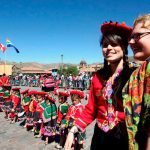This article was posted on Saturday, September 12th, 2015 at 1:22 am and is filed under Tours of Peru.
Two of the best places to visit in Peru are the open-air markets in Chinchero and Písac, a colorful addition to some of the best Inca Trail tours.
Open-air markets are places of abundance. They are colorful, noisy, and full of potentially unique bargains, from trinkets to intricately-woven textiles. You will be treated to an over-abundance of photo-ops, and to friendly locals who are there to please, to sell and, at times, to socialize.
Both Písac and Chinchero markets draw native Andean women (and a few men) from the surrounding villages, and both have traditions that are centuries old. They are unique experiences in their own right, however, and we recommend you spend time in both, whenever possible.
A centuries-old tradition
The markets are an ancient tradition carried from generation to generation. Some villagers walk for hours each week from their homes in small villages in the Sacred Valley to set up their wares. Some sell handcrafted goods to the hundreds of tourists who pass by; others make the journey to barter.
Many native vendors also follow tradition by wearing their colorful Quechan costumes, especially on Sundays. Each hand-made garment is woven to include a distinctive design element; natives use that design to instantly identify where the garment was made, whether in the surrounding villages of Písac, Chinchero, or other locations throughout Peru.
The Birthplace of the Rainbow: Chinchero
The Chinchero market is arguably more traditional than the larger Pisac Market. Chinchero has a Spanish medieval look, and is a small, sleepy Andean village on every day except Sunday. That’s when the market, centered around a plaza in the older section of town, takes over, and spreads out onto the narrow cobblestone streets surrounding the central square.
Chinchero, the town, is at a high elevation. Situated at over 12,000 feet (as versus Písac at 9,700) it is traditionally believed to be the “birthplace of the rainbow.” Perhaps its elevation is one of the reasons for the traditional independence of the people of Chinchero, and the resultant unique quality of the textiles they produce.
The artisans of Chinchero make beautiful clothing, rugs, shawls, ponchos and other textiles, using a unique weaving process that had been developed over centuries, and sometimes includes record-breaking thread counts. The increasing popularity of the Chinchero market is due in large part to these textiles, which are offered in a sea of color at the Sunday markets.
The Písac Market
Písac is one of the biggest open-air markets in all of South America. The official market days are Tuesday, Thursday and Sunday, although you can often find a few vendors there any day of the week. Sunday is by far the most heavily-attended, both by native vendors and tourists alike.
Písac’s history traces to the mid-sixteenth century. It was originally built as a small town on the banks of the Urubamba River, near an ancient Inca settlement. Now, Písac is a thriving town of several thousand people, and stretches along both sides of the river.
Písac’s marketplace is in the older part of town, as it has been for centuries. Or, at least, that is where it begins. With booths numbering into the hundreds and stretching from the small central plaza and onto the sloped streets, the Sunday markets are huge.
The Mercado de Treque
On Sundays only, farmers and peasants (campesínos) from outlying towns come to Písac to set up an adjacent barter market, called the Mercado de Treque. Often speaking ancient Quechan, they trade their own produce (potatoes, herbs and other vegetables) for essentials like salt, sugar, matches, oranges and medicine.
Functioning side-by-side, the “regular” market and the barter market are wonderful places to shop and just to watch. The Mercado de Treque, in particular, offers ample opportunities to observe traditional bartering.
Bartering (also in some circles known as haggling) is, in fact, a much-prized skill in both markets, often earning the best prices for top-quality goods. It is a friendly banter, requiring patience, skill, and at least a rudimentary understanding of Spanish.
Although the main market closes at 5 p.m., the Mercado de Treque closes at 3, probably so the natives (some who trek five hours each way) can get home before dark.
The markets are awash with color, noise, and photo opportunities at any time. They are a must-see even if you buy nothing (although that will be hard). Chinchero, in particular, has the most spectacular pictures near sunset. For more information on how you can make your trip to the markets of Peru a reality, contact us at bestperutours.com.







